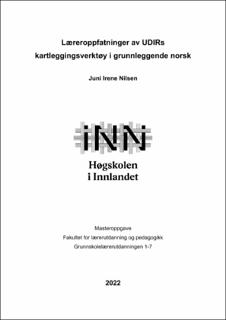| dc.contributor.advisor | | |
| dc.contributor.author | Nilsen, Juni Irene | |
| dc.date.accessioned | 2022-09-20T16:18:15Z | |
| dc.date.available | 2022-09-20T16:18:15Z | |
| dc.date.issued | 2022 | |
| dc.identifier | no.inn:inspera:109713146:72027608 | |
| dc.identifier.uri | https://hdl.handle.net/11250/3019783 | |
| dc.description.abstract | Minoritetsspråklige elever som ankommer Norge og starter i grunnskolen og videregående har ifølge opplæringslova §2-8 og §3-12 rett på særskilt norskopplæring frem til de har «tilstrekkelig kunnskap» i norsk til å følge ordinær undervisning. Før disse vedtakene gjøres skal elevene få en sakkyndig vurdering, en oppgave som ofte påfaller lærerne til elevene. Hva som er tilstrekkelig kunnskap kan være vanskelig å vurdere, og UDIRs kartleggingsverktøy i grunnleggende norsk er derfor blitt laget som støtte til lærere når de skal kartlegge elevenes norskferdigheter for å finne ut hvilken opplæring elevene trenger.
I kartleggingsverktøyets veileder står det at de som bruker det bør har andrespråkskompetanse, noe flere lærere opplever er utfordrende. Jeg har derfor spurt informantene om hvordan de har løst dette på sin skole, og hva de synes er utfordrende med det. I tillegg skal vurderingen av elevenes språkferdigheter være dynamisk, med lærerens aktive støtte som en del av vurderingsgrunnlaget. Dette er fortsatt en ukonvensjonell måte å vurdere elever på, og møtes med noe skepsis fra lærerne. Til slutt har jeg undersøkt hvordan lærerne kartlegger verktøyets fem språkferdigheter, og sett på hvordan dette samsvarer med verktøyets egen teori om hva språk er. | |
| dc.description.abstract | This master thesis is named “Teacher opinions on the Norwegian Directorate for Education and Training’s tool for assessing the Norwegian language proficiency of pupils from language minorities”, and its objective is as such to investigate how a small number of teachers understand and use the assessment tool to map their pupils’ Norwegian language proficiency. The legal and political background for this thesis is that according to the Education Act §2-8 and §3-12, pupils of language minorities who attend Norwegian schools have the right to receive adapted language education until they are “sufficiently proficient in Norwegian to follow the normal instruction of the school. » What “sufficient proficiency of Norwegian” means is unclear and implies that it is up to the teachers to decide when they think their pupils can attend regular classes.
The aim of the assessment tool is to help teachers make this decision through assessing their pupils’ language proficiency by marking the various criteria found in the assessment tool. The criteria are based on the Norwegian Curriculum for pupils from language minorities. The instructions of the assessment tool emphasizes that teachers should have competence in second language acquisition. This proposes a practical challenge according to my informants, among other things because some schools let school assistants assess the pupils. The tool itself is using specific terminology and is based on dynamic assessment, the latter which includes active involvement from the teaches as she/he is assessing the pupils. This means that whoever uses the tool must read the theoretical background carefully in order to use the tool as it is meant to be used. Finally, I have asked my informants to share how they assess the five different language skills that the assessment tool is based on, to see what they think are important aspects when you assess language proficiency and how this cohere to the theory of language acquisition that the assessment tool is based on. | |
| dc.language | nob | |
| dc.publisher | Inland Norway University | |
| dc.title | Læreroppfatninger av UDIRs kartleggingsverktøy i grunnleggende norsk | |
| dc.type | Master thesis | |
